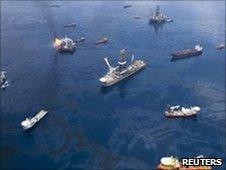Gulf of Mexico oil spill claims to be 'paid quickly'
- Published

The oil slick now covers an area of sea the size of Scotland
The man running the $20bn (£13.5bn) fund to compensate Gulf of Mexico oil spill victims says he is determined to speed up the payment of claims.
Kenneth Feinberg said President Barack Obama wanted to "get these claims paid. Get them paid quickly".
He also said he would "err on the side of the claimant" in assessing emergency claims from fishermen and businesses.
Oil giant BP agreed to bankroll the fund, under pressure from Mr Obama, after the sinking of its rig in April.
Meanwhile, a worker on the Deepwater Horizon platform - which exploded and sank killing 11 workers - has told the BBC's Panorama programme he had identified a leak in the rig's safety equipment weeks before the blast.
Tyrone Benton said the leak was not fixed at the time, but that the faulty device was shut down instead and a second one relied on.
Mr Feinberg ran the victims' claim fund set up in the wake of the 11 September 2001 attacks in New York and Washington.
"We've got to get the claims out quicker," he told CNN. "We've got to get them out with more transparency so that claimants understand what the status is of their claim.
"And we've got to ease the burden on these folks in the Gulf. I was there last week. I'll be there tomorrow. We've got to accelerate the process just as the president instructed me to do."
He added: "With the emergency payments... you've got to allow those payments to go out with less corroboration than you would if you're giving a lump-sum payment that is the total compensation.
"For the emergency payments, we've got to err on the side of the claimant."
Mr Feinberg has said that individuals and businesses affected by the spill can file a claim for compensation for lost wages or profits, personal injuries or even death.
His latest comments came after BP said that its costs so far of tackling the oil spill and compensating victims had risen to $2bn, including $105m paid out to 32,000 claimants.
Critical
On 20 April, when the Deepwater Horizon rig exploded, the blowout preventer (BOP) device failed.
The most critical piece of safety equipment on the rig, it is designed to avert disasters just like the oil spill in the Gulf of Mexico.
The blowout preventer has giant shears designed to cut and seal off the well's main pipe.
The control pods are effectively the brains of the blowout preventer and contain both electronics and hydraulics.
This is where Mr Benton said the problem had been found.
"We saw a leak on the pod, so by seeing the leak we informed the company men," Mr Benton said of the earlier problem he had identified.
"They have a control room where they could turn off that pod and turn on the other one, so that they don't have to stop production."
Mr Benton said his supervisor e-mailed both BP and Transocean, the owner of the rig, about the leaks when they were discovered.
He said he did not know whether the leaking pod had been turned back on before the disaster or not.
He said to repair the control pod would have meant temporarily stopping drilling work on the rig at a time when it was costing BP $500,000 (£337,000) a day to operate the Deepwater Horizon rig.
Henry Waxman, a House of Representatives Democrat who is overseeing congressional investigations into the rig disaster, has accused BP of taking safety shortcuts to save money.
"BP appears to have made multiple decisions for economic reasons that increased the danger of a catastrophic well failure," Mr Waxman said.
BP chief executive Tony Hayward, giving evidence to Congress, said: "There is nothing I have seen in the evidence so far that suggests that anyone put cost ahead of safety - if there are then we will take action."
Congress has identified numerous other problems with the blowout preventer, including design problems, unexpected modifications and a flat battery.
The other major problems on the rig, Congress has said, centred on the cement job. Cement in an oil well blocks explosive gases from escaping, and it appears the cement may not have been set properly on the Deepwater Horizon platform.
BP said it had had indications of a successful cementing operation and the company that was in charge of the cement job, Halliburton, has said it was consistent with that used in similar applications.
The BBC spoke to several rig workers who were on the Deepwater Horizon rig and they said there had been pressure in April to work fast.
Work to prepare and then seal the well was behind schedule and had to be completed before a production rig could move in and start turning profits.
"Too many jobs were being done at one time. It should have just really slowed down and just took one job at a time, to make sure everything was done the way it should have been," said Mr Benton, who is now suing BP and Transocean for negligence.
BP has responded to Mr Benton's account saying Transocean was responsible for both the maintenance and operation of the blowout preventer.
